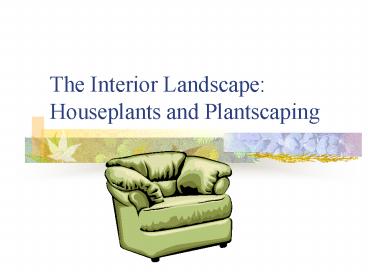The Interior Landscape: Houseplants and Plantscaping - PowerPoint PPT Presentation
1 / 16
Title:
The Interior Landscape: Houseplants and Plantscaping
Description:
Before caring for a plant you need to answer the following questions. ... which is in the form of small beads, which are coated with plastic and dissolved ... – PowerPoint PPT presentation
Number of Views:404
Avg rating:3.0/5.0
Title: The Interior Landscape: Houseplants and Plantscaping
1
The Interior LandscapeHouseplants and
Plantscaping
2
Caring for Interior Plants
- Before caring for a plant you need to answer the
following questions. - What is the proper way to water the plant?
- How much light does it need?
- What is the best Temperature for optimum growth?
- What type of soil mixture is needed?
3
Caring for Interior Plants
- Watering
- You must carefully observe each plant and how
many times you water it. - Signs of improper watering are
- Drooping leaves
- Wilting leaves
- Yellow leaves
- You will also need to look at the moisture
control, and if there is proper drainage.
4
Caring for Interior Plants
- There are different ways in watering plants
- They are
- Drench and let dry This is where water is
added and then you let the soil dry out until you
water again. - Drench and let dry slightly This is where water
is added and you let the soil dry slightly and
then water again. So the soil will be moist when
you water again.
5
Caring for Interior Plants
- The last method is of water is
- Keep medium constantly moist at all time so it is
moist to the touch.
6
Caring for Interior Plants
- Lighting
- What is photosynthesis?
- It is the process of manufacturing food
7
Caring for Interior Plants
- What is Light Meters?
- small machines that measure illumination or
light. You can find these at florist, garden
centers and department stores.
8
Caring for Interior Plants
- Light Intensity requirements
- There are three groups, they are
- Direct sun plant should receive full intensity
of natural sunlight. - Partial sun or weak sun plant should receive
less than 50 of natural light - Indirect or filtered light plant should receive
no direct sunlight at all.
9
Caring for Interior Plants
- Artificial lighting
- The fluorescent light enables horticulturist too
- Root cuttings of interior plants more easily
- Start seeds of new and different interior plants
- Grow tropical plants, cacti and succulents with
greater ease
10
Caring for Interior Plants
- Temperature
- The recommended temperature for plants indoors
are between 50 degrees F to 85 degrees F.
11
Caring for Interior Plants
- Humidity
- It is the percent of moisture in the air which
is an important factor to consider when growing
interior plants
12
Caring for Interior Plants
- Humidity
- Humidity around interior plants can be increased
by - Spraying a fine mist of water on the foliage of
the plant with an inexpensive plastic spray
bottle or any type of mister. - using a watertight try filled with small pea
gravel to hold the potted plants. Water is added
to the tray to come to the top of the gravel and
plant are set on the gravel, making certain that
the pots are not actually in the water.
13
Caring for Interior Plants
- Humidity
- Using a humidifier to provide the moisture in the
air. - Placing the plant in a part of the house that has
the highest humidity . Examples are bathroom,
and kitchen
14
Caring for Interior Plants
- Soil Mixture
- A good general potting mixture includes two
parts loamy soil, one part organic matter such as
peat moss and ect.. One part course sand and
horticultural grade perlite
15
Caring for Interior Plants
- Fertilizers
- There are two types of interior plant fertilizers
on the market today. They are - Slow released which is in the form of small
beads, which are coated with plastic and
dissolved over a period of time and is applied
to the soil mixture. - Soluble fertilizer is available in liquid or
solid form. When using the solid form it must be
dissolved in water before applying to soil.
16
Caring for Interior Plants
- You will need your books and will need to read
pages 221 starting at potting plants and read to
page224 and stopping at indoor plant chart. You
will need to take notes over these pages and turn
them in for a note grade.































